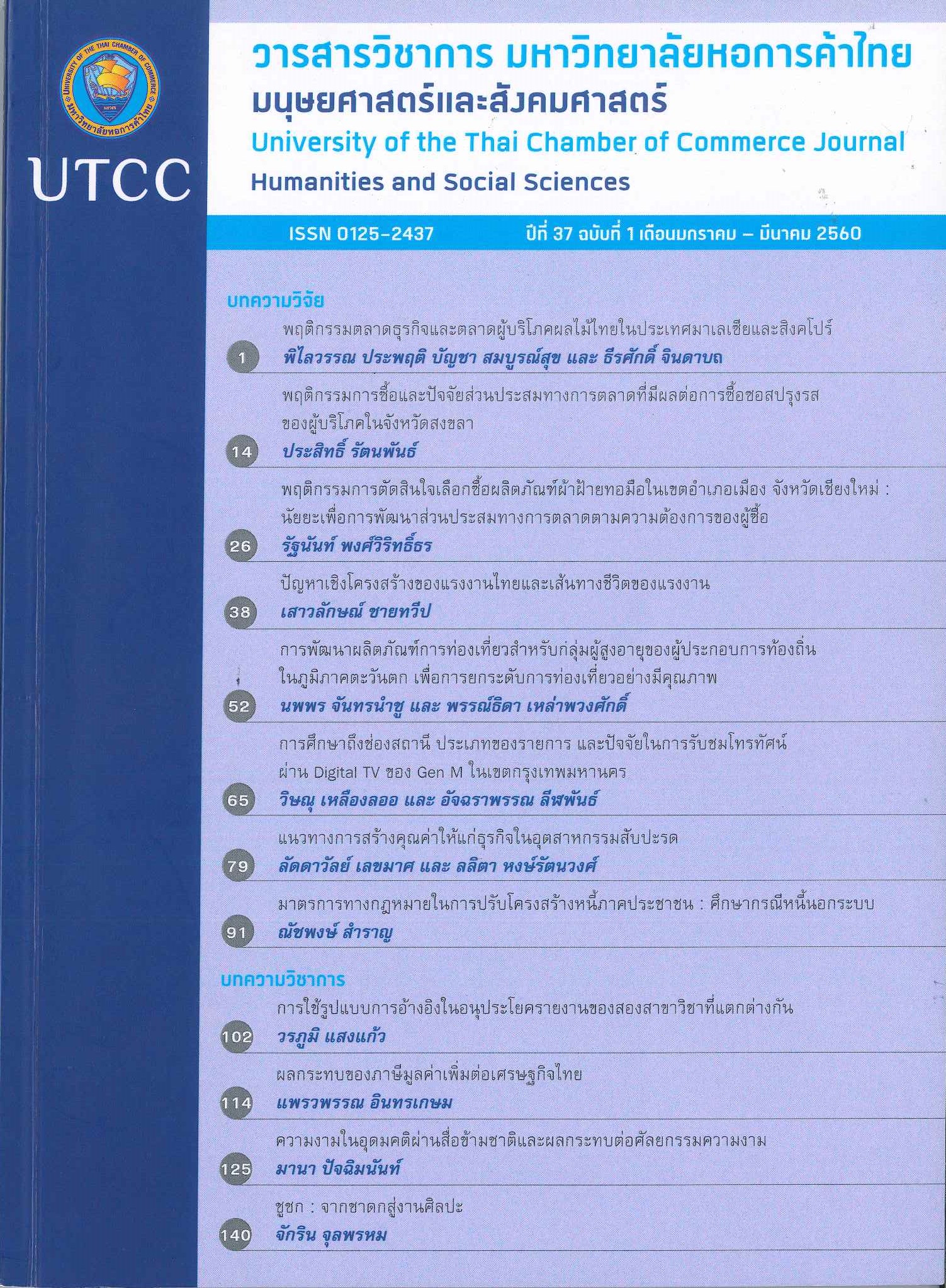Development of Tourism Products for Elderly Group by Local Operators in the Western Region for Enhanced Quality Tourism
Main Article Content
Abstract
This research has 3 objectives: 1) to explore the capacity to develop tourism products for elderly group of local operators in the western region; 2) to develop tourism products for elderly group by local operators; and 3) to recommend guidelines for developing tourism products for elderly group by local operators. Research methodology involved 3 stages. Stage 1 was to explore the capacity to develop tourism products by documentary study, in-depth interview, and focus group discussion with 34 key informants. Stage 2 was to develop tourism products using participatory action research with 18 key informants of Muang Petch sugar palm inheriting group,
Petchaburi province. Stage 3 was to recommend guidelines for developing tourism products by conducting a learning and exchange meeting with 30 participants. Quantitative analysis included frequency, percentage, arithmetic mean, and standard deviation. Qualitative analysis employed content analysis, and inductive analysis. Research results revealed the followings. 1. The capacity to develop tourism products comprised creativity in tourism products, organization of tourism activities, provision of tourism services, and marketing promotion of tourism products. Success factors consisted of various aspects, i.e. learning, tourism resources, facilities, external support, and tourism products network. 2. The development of tourism products for elderly group involved the aspects of product size, product benefit, product feature, and product packaging. 3. The guidelines for developing tourism products included 1. Tourism operators should improve facilities and organize
health promoting tourism activities while considering safety, including learning promotion, and staff development in providing services to elderly tourists. 2. The community products operators should develop the products focusing on local identity, utilization of community materials, usefulness, production standards, and marketing network. 3. Operating level agencies should coordinate in improving public utility system and facilities, promotion of product development, and marketing
promotion so as to promote tourism for elderly people. 4. Policy level agencies should provide a policy concerning tourism operator network, and make a strategic plan in the development of products and marketing for elderly tourism as well as the development of tourism service standardsfor elderly people.
Article Details
ลิขสิทธิ์ของบทความ
ผลงานที่ได้รับการตีพิมพ์ถือเป็นลิขสิทธิ์ของมหาวิทยาลัยหอการค้าไทย ห้ามมิให้นำเนื้อหา ทัศนะ หรือข้อคิดเห็นใด ๆ ของผลงานไปทำซ้ำ ดัดแปลง หรือเผยแพร่ ไม่ว่าทั้งหมดหรือบางส่วนโดยไม่ได้รับอนุญาตเป็นลายลักษณ์อักษรจากมหาวิทยาลัยหอการค้าไทยก่อน
References
Chantaranamchoo, N., Rattanapongpinyo, T., & Ratasasansart, D. (2014). Developing strategies for cultural tourism based on creative economy of four Dvaravati provinces toward ASEAN community. University of the Thai Chamber of Commerce Journal, 34(4), 1-15. (in Thai).
Chongsathitwatana,P. (2005). Marketing management: Analysis, strategy anddecision. 7th ed.). Bangkok: Thammasat University. (in Thai).
Dickman,S. (1996). Tourism: An introductory text.(2nd ed.). Sydney: Hodder Education.
Kim, H., Woo, E., & Uysal, M.(2015). Tourism experience and quality of life among elderly tourists. Tourism Management,46:456-476.
Lord, S., Despres, C., & Ramadier, T .(2012). When mobility makes sense: A qualitative and longitudinal study of the daily mobility of the elderly. Journal of Environmental
Psychology, 31(1), 52-61.
Murphy, P.E.(2000).Tourism: A community approach. New York, NY: Methuen.
Pongwiritthon, R., & Pakvipak, P. 2015. Guidelines for developing community products fora sustainable and creative economy: A case study of Ban Mae Pu-ka, Sankamphang, Chiang Mai. University of the Thai Chamber of Commerce Journal,35 (2) ,44-58. (in Thai).
Sawanpanapan, K. (2012). Sustainable tourism potential of the Tan Tanod: A case study of Tan Tanod Community, Tham Rong Sub District, Ban Lat District, Phetchaburi
Province. (Unpublished master's thesis). Silpakorn ,University, Bangkok. (in Thai).
UNESCO. (2006). Discussion repoort of the planning meetine for 2008 international conference on creative tourism. Sanata Fe,NM: Author.
Uysal, M., & Hagan, L.A. 1993. Motivatioins of pleasure travel and tourism. In M. Khan, M. Olsen, & T. Car (Eds.), Encyclopedia of hospitality and tourism (pp. 798-810). New York, NY: Van Nostrand Reinhold.
Yaiying, U., & Thirawong, K. (2010). Research and development potential tourism resource for supporting agro-tourism in Mlabri community, Rongkwang District, Phrae Province. Chiang Mai: Maejo University, Chiang Mai. (in Thai).

